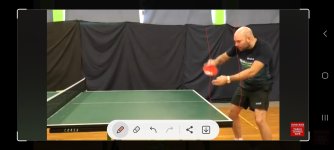By the way, your missing the ball or it catching the edge of your racket means you need to watch the flight of the ball better. But it also means your brain is set for something else and so you are having a hard time seeing the ball. If you get someone to just give you that serve a bunch of times and you are not trying to hit the ball but really try and watch it, when it is hit at you in a match, you will see it more accurately.
It is like, if you were playing an anti-spin player and you did not know they had anti-spin, and you push, and they push back, you would see the ball as though it was underspin even though it is not. Your brain is set for something and so you are not seeing what is actually there. You need to practice to see through the illusion and the deception.
That is really a simple serve. He is not really doing much to disguise it. You can easily see his racket the whole time. Once you are used to it, it will be no problem for you. It will just be a matter of practice and getting used to this serve.












